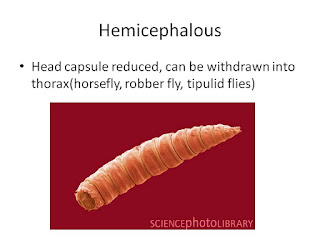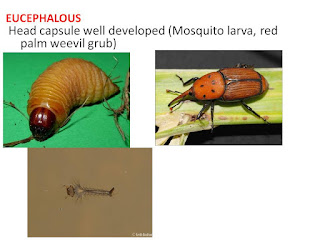Larva & Pupa
TYPES OF LARVAE
Larva
is the second immature stage of insects, which is the active stage. It is the
stage between egg and pupal stages in insects with complete metamorphosis.
Larvae totally differ from the adults.
Types of larvae
Larval
type
|
Description
(Example)
|
Protopod
|
Resembles
immature embryo, abdominal segmentation absent, thoracic and cephalic
appendages rudimentary (Early instars of endoparasitic hymenoptera)
|
Oligopod
|
Thoracic
legs only
|
Campodeiform
|
Body
flattened with a typical prognathous head well developed thoracic legs
(ladybird beetle, aphidlions and antlions)
|
Scarabaeiform
|
Stout
semi cylindrical, C-shaped fleshy body, legs shorter (Coconut Rhinoceros
beetle grub)
|
Elateriform
|
Flat,
linear, long, resemble a rusted wire (click beetle)
|
Polypod / eruciform
|
Thoracic
legs well developed, five paries of prolegs, one pair each on abdominal
segments 3-6 and 10 (clasper) (Caterpillars)
|
Hairy
|
Sparase,
dense, or tufts of irritating hairs all over the body (groundnut red hairy
caterpillars)
|
Spiny
|
Spine
like out growths on the body (Castor spiny caterpillar)
|
Slug
|
Short,
robust, fleshy, thoracic legs minute,
head small, retractile, prolegs absent, poisonous spines (scoli) all over the
body (Castor slug caterpillar)
|
Semilooper
|
Prolegs
on segments 3 and 4 either absent or vestigial, larva forms a semi loop when moving
(castor semilooper)
|
Looper
|
Prolegs
in segments 6 and 10 only, larva forms a complete loop, stick like (Daincha
looper)
|
Apodous
|
Leg
less, with or without head capsule
|
Acephalous
|
Head
absent, mouth hooks (Housefly maggot)
|
Hemicephalous
|
Head
capsule reduced, can be withdrawn into thorax(horsefly, robber fly, tipulid
flies)
|
Eucephalous
|
Head
capsule well developed (Mosquito larva, red palm weevil grub)
|
TYPES OF PUPA
Pupa
is the resting stage in all holometabolan insects. During this stage the larval
characters are destroyed and adult features are created wherein the gonads
mature, mouthparts, the digestive system reorganized and wings develop. Based
on the nature of attachment of appaendages, insect pupae are classified into
three main types.
Types of pupae
Pupal type
|
Description
|
Obtect
|
Antenna,
wing pads, legs and other appendages fused to the body, many obtect pupae
often protected by cocoon constructed using various materials (moths)
Silken
cocoon(silk) - Silkworm
Earthen
cocoon (soil + saliva) – Gram pod borer
Hairy
cocoon (body hair) – Woolly bear
Frassy
cocoon (frass + saliva) – Coconut black headed caterpillar
Fibrous
cocoon (fibres) – Coconut red palm weevil
Leafy
cocoon (leaf + silk fibres) – Leaf folder
|
Chrysalis
|
Angular,
attached to the substratum by a hook like structure at the end of the abdomen
(cremaster) and by two silken threads over the midregion of the body (Girdle)
(butterflies)
|
Tumbler
|
Comma
shaped with rudimentary appendages, breathing trumpets in the cephalic
region, anal paddles at the abdominal end (Mosquito)
|
Exarate
|
Antenna,
wing pads, legs and other appendages free, not glued to the body (Beetles,
bees)
|
Coarctate
|
Larval
skin (exuviae) hardens, barrel-like, air and water proof case (puparium),
covers the pupa (True files)
|
Alternatively,
based on the articulation and development of mandibles, pupae may be adecticous
and decticous. In adecticous pupae, the mandibles are often reduced and not
articulated whereas in decticous type, the mandibles are well developed and
often articulated.











































Comments
Post a Comment